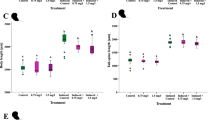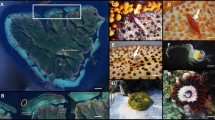Abstract
Infochemicals play important roles in aquatic ecosystems. They even modify food web interactions, such as by inducing defenses in prey. In one classic but still not fully understood example, the planktonic freshwater crustacean Daphnia pulex forms specific morphological defenses (neckteeth) induced by chemical cues (kairomones) released from its predator, the phantom midge larva Chaoborus. On the basis of liquid chromatography, mass spectrometry, and chemical synthesis, we report here the chemical identity of the Chaoborus kairomone. The biologically active cues consist of fatty acids conjugated to the amino group of glutamine via the N terminus. These cues are involved in Chaoborus digestive processes, which explains why they are consistently released despite the disadvantage for its emitter. The identification of the kairomone may allow in-depth studies on multiple aspects of this inducible defense system.
This is a preview of subscription content, access via your institution
Access options
Access Nature and 54 other Nature Portfolio journals
Get Nature+, our best-value online-access subscription
$29.99 / 30 days
cancel any time
Subscribe to this journal
Receive 12 print issues and online access
$259.00 per year
only $21.58 per issue
Buy this article
- Purchase on Springer Link
- Instant access to full article PDF
Prices may be subject to local taxes which are calculated during checkout





Similar content being viewed by others
Data availability
All raw data will be provided upon reasonable request.
References
Hay, M. E. Marine chemical ecology: chemical signals and cues structure marine populations, communities, and ecosystems. Ann. Rev. Mar. Sci. 1, 193–212 (2009).
Atema, J., Fay, R. R., Popper, A. N. & Tavolga, W. N. Sensory Biology of AquaticAnimals. (Springer, New York, NY, 1988)..
Brönmark, C. & Hansson, L.-A. Chemical Ecology in Aquatic Systems. (Oxford University Press, 2012).
Pohnert, G., Steinke, M. & Tollrian, R. Chemical cues, defence metabolites and the shaping of pelagic interspecific interactions. Trends Ecol. Evol. 22, 198–204 (2007).
Jeschke, J. M., Kopp, M. & Tollrian, R. Predator functional responses: discriminating between handling and digesting prey. Ecol. Monogr. 72, 95–112 (2002).
Dicke, M. & Grostal, P. Chemical detection of natural enemies by arthropods: an ecological perspective. Annu. Rev. Ecol. Syst. 32, 1–23 (2001).
Verschoor, A. M., Vos, M. & Van Der Stap, I. Inducible defences prevent strong population fluctuations in bi- and tritrophic food chains. Ecol. Lett. 7, 1143–1148 (2004).
Kats, L. B. & Dill, L. M. The scent of death: chemosensory assessment of predation risk by prey animals. Ecoscience 5, 361–394 (1998).
Lampert, W. & Kinne, O. Daphnia: development of a model organism in ecology and evolution. Excellence in Ecology 21, 1–275 (2011).
Weiss, L. C., Laforsch, C. & Tollrian, R. Chemical Ecology in Aquatic Systems. (eds. Lars-Anders Hannsson, L.-A. & Brönmark, C.) 111–126 (2012).
Krueger, D. & Dodson, S. I. Embryological induction and predation ecology in Daphnia pulex. Limnol. Oceanogr. 26, 219–223 (1981).
Weiss, L. C. et al. Onset of kairomone sensitivity and the development of inducible morphological defenses in Daphnia pulex. Hydrobiologia 779, 135–145 (2016).
Tollrian, R. & Harvell, C. D. The Ecology and Evolution of Inducible Defenses. (Princton University Press, Princton, New Jersey, 1999).
Tollrian, R. Chaoborus crystallinus predation on Daphnia pulex: can induced morphological changes balance effects of body size on vulnerability? Oecologia 101, 151–155 (1995).
Tollrian, R., Duggen, S., Weiss, L. C., Laforsch, C. & Kopp, M. Density-dependent adjustment of inducible defenses. Sci. Rep. 5, 12736 (2015).
Weiss, L. C., Leimann, J. & Tollrian, R. Predator-induced defences in Daphnia longicephala: location of kairomone receptors and timeline of sensitive phases to trait formation. J. Exp. Biol. 218, 2918–2926 (2015).
Weiss, L. C., Leese, F., Laforsch, C. & Tollrian, R. Dopamine is a key regulator in the signalling pathway underlying predator-induced defences in Daphnia. Proc. Biol. Sci. 282, 20151440 (2015).
Weiss, L. C., Kruppert, S., Laforsch, C. & Tollrian, R. Chaoborus and gasterosteus anti-predator responses in Daphnia pulex are mediated by independent cholinergic and gabaergic neuronal signals. PLoS One 7, e36879 (2012).
Miyakawa, H. et al. A mutation in the receptor Methoprene-tolerant alters juvenile hormone response in insects and crustaceans. Nat. Commun. 4, 1856 (2013).
Beckerman, A. P., de Roij, J., Dennis, S. R. & Little, T. J. A shared mechanism of defense against predators and parasites: chitin regulation and its implications for life-history theory. Ecol. Evol. 3, 5119–5126 (2013).
Parejko, K. & Dodson, S. Progress towards characterization of a predator- prey kairomone: Daphnia pulex and Chaoborus americanus. Hydrobiologia 198, 51–59 (1990).
Tollrian, R. & Von Elert, E. Enrichment and purification of Chaoborus kairomone from water: Further steps toward its chemical characterization. Limnol. Oceanogr. 39, 788–796 (1994).
Alborn, H. T. An elicitor of plant volatiles from beet armyworm oral secretion. Science 276, 945–949 (1997).
Pohnert, G., Jung, V., Haukioja, E., Lempa, K. & Boland, W. New fatty acid amides from regurgitant of Lepidopteran (Noctuidae, Geometridae) caterpillars. Tetrahedron 55, 11275–11280 (1999).
Halitschke, R., Schittko, U., Pohnert, G., Boland, W. & Baldwin, I. T. Molecular interactions between the specialist herbivore Manduca sexta (Lepidoptera, Sphingidae) and its natural host Nicotiana attenuata. III. Fatty acid-amino acid conjugates in herbivore oral secretions are necessary and sufficient for herbivore-specific plant responses. Plant Physiol. 125, 711–717 (2001).
Mori, N., Alborn, H. T., Teal, P. E. A. & Tumlinson, J. H. Enzymatic decomposition of elicitors of plant volatiles in Heliothis virescens and Helicoverpa zea. J. Insect Physiol. 47, 749–757 (2001).
Mori, N. & Yoshinaga, N. Function and evolutionary diversity of fatty acid amino acid conjugates in insects. J. Plant Interact. 6, 103–107 (2011).
Dowhan, W. & Bogdanov, M. in Biochemistry of Lipids, Lipoproteins and Membranes (eds. Vance, J. E. & Vance, D. E.) 1–37 (Elsevier Science, 2002).
Selander, E. et al. Predator lipids induce paralytic shellfish toxins in bloom-forming algae. Proc. Natl. Acad. Sci. USA 112, 6395–6400 (2015).
Kusch, J. & Heckmann, K. Isolation of the Lembadion-factor, A morphogenetically active signal, that induces Euplotes cells to change from their ovoid form into a larger lateral winged morph. Dev. Genet. 13, 241–246 (1992).
Yasumoto, K. et al. Isolation of new aliphatic sulfates and sulfamate as the Daphnia Kairomones inducing morphological change of a phytoplankton Scenedesmus gutwinskii. Chem. Pharm. Bull. (Tokyo) 56, 133–136 (2008).
Yasumoto, K. et al. Aliphatic sulfates released from Daphnia induce morphological defense of phytoplankton: isolation and synthesis of kairomones. Tetrahedr. Lett. 46, 4765–4767 (2005).
Alborn, H. T., Jones, T. H., Stenhagen, G. S. & Tumlinson, J. H. Identification and synthesis of volicitin and related components from beet armyworm oral secretions. J. Chem. Ecol. 26, 203–220 (2000).
Paré, P. W., Alborn, H. T. & Tumlinson, J. H. Concerted biosynthesis of an insect elicitor of plant volatiles. Proc. Natl. Acad. Sci. USA 95, 13971–13975 (1998).
Yoshinaga, N. et al. Active role of fatty acid amino acid conjugates in nitrogen metabolism in Spodoptera litura larvae. Proc. Natl. Acad. Sci. USA 105, 18058–18063 (2008).
Colbourne, J. K. et al. The ecoresponsive genome of Daphnia pulex. Science 331, 555–561 (2011).
Tollrian, R. Neckteeth formation in Daphnia pulex as an example of continuous phenotypic plasticity morphological effects of Chaoborus. J. Plankton Res. 15, 1309–1318 (1993).
Acknowledgements
We dedicate our study to the memory of our inspiring friend S. Dodson. He would have loved to see the results. We thank G. Pohnert for discussion and S. Gorb and S. Kruppert for providing the Chaoborus predation sequence. We thank L. Weider (University of Oklahoma) for the R9 clone and T. White for language editing.
Author information
Authors and Affiliations
Contributions
L.C.W. and R.T. designed the research; M.L. performed the initial ESI–MS analysis, J.Z. prepared the first kairomone derivative; L.C.W. and R.T. designed and L.C.W. and S.M.B. conducted biological experiments; B.A. and N.M.-N. prepared the synthetic kairomone derivatives, U.S. performed chemical analysis; S.W.M., J.K., M.M., and O.J.S. quantified the kairomone concentration; L.C.W., R.T., B.A., and N.M.-N. wrote the manuscript; all authors contributed to the final version of the manuscript.
Corresponding author
Ethics declarations
Competing interests
The authors declare no competing interests.
Additional information
Publisher’s note: Springer Nature remains neutral with regard to jurisdictional claims in published maps and institutional affiliations.
Supplementary information
Supplementary Text and Figures
Supplementary Tables 1–6, Supplementary Figures 1–8
Supplementary Note 1
Synthetic Procedures
Rights and permissions
About this article
Cite this article
Weiss, L.C., Albada, B., Becker, S.M. et al. Identification of Chaoborus kairomone chemicals that induce defences in Daphnia. Nat Chem Biol 14, 1133–1139 (2018). https://doi.org/10.1038/s41589-018-0164-7
Received:
Accepted:
Published:
Issue Date:
DOI: https://doi.org/10.1038/s41589-018-0164-7
This article is cited by
-
RNA-seq analysis reveals changes in mRNA expression during development in Daphnia mitsukuri
BMC Genomics (2024)
-
Common fear molecules induce defensive responses in marine prey across trophic levels
Oecologia (2023)
-
Daphnia as a versatile model system in ecology and evolution
EvoDevo (2022)
-
Variation in volatile organic compounds in Atlantic salmon mucus is associated with resistance to salmon lice infection
Scientific Reports (2022)
-
Aquatic chemical ecology meets ecotoxicology
Aquatic Ecology (2022)



